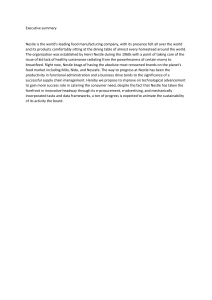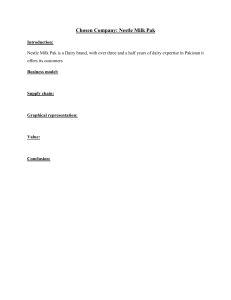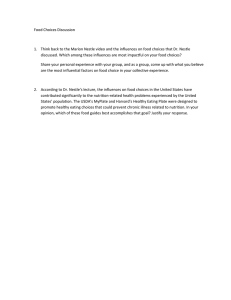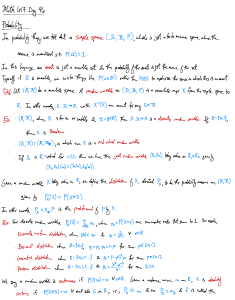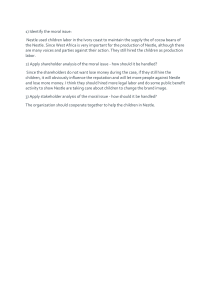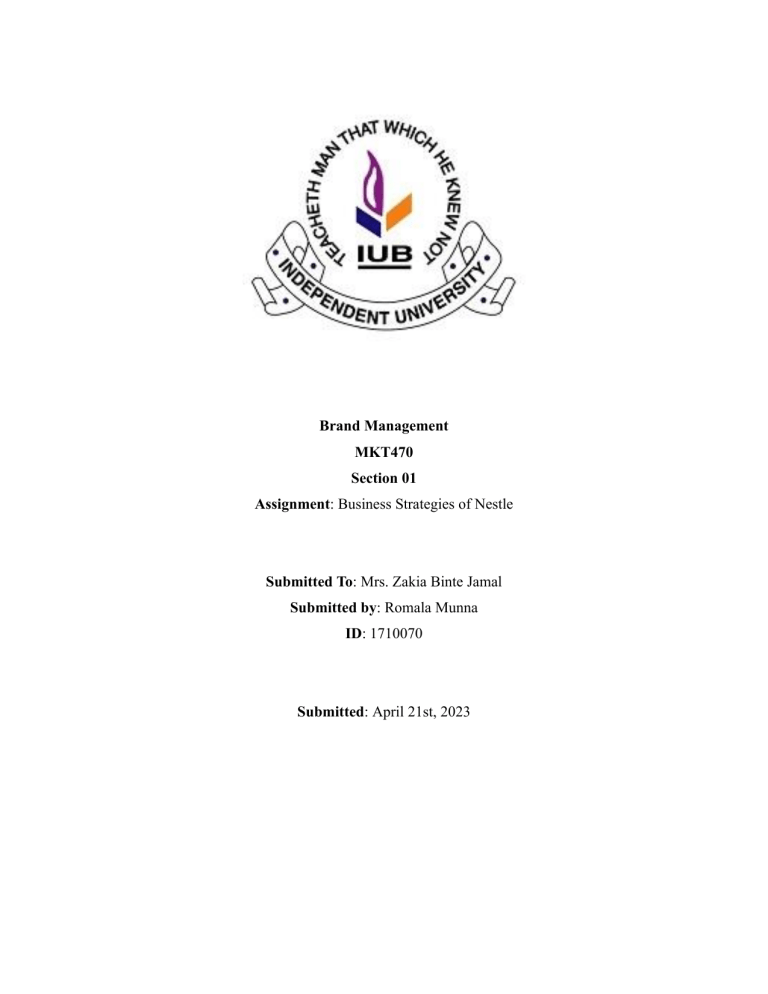
Brand Management MKT470 Section 01 Assignment: Business Strategies of Nestle Submitted To: Mrs. Zakia Binte Jamal Submitted by: Romala Munna ID: 1710070 Submitted: April 21st, 2023 Mkt470 Brand Management Business Strategies of Nestle Table of Contents Company Overview Business Strategies Differentiation Diversification Innovation Developing Branding & Marketing Mergers & Acquisitions Sustainability Conclusion Independent University, Bangladesh 3 4 4 5 5 5 6 6 6 2 Mkt470 Brand Management Business Strategies of Nestle Company Overview Nestle is the largest food company, currently operating in over 190 countries worldwide, associated with more than 2000 brands and with a work force of about 300000 employees. Nestle started its journey in 1866, founded by Henri Nestle, a German immigrant who developed and launched an affordable substitute for breast milk. It started out as a booming business in the infant formula industry. Nestle actually had a cold war with the Page Brothers, George and Charles Page, for about 30 years, famous at that time for their condensed milk worldwide. The Page brothers began their journey in 1866, alongside Nestle in Switzerland. By 1905, after the death of the Page brothers and Nestle, the two companies were merged together, resulting in about 20 factories. Nestle faced some backlash after World War I, but with the help of Uncle Sam and several different business strategies Nestle was able to increase in size on a double scale and continued from there on. Nestle has major product diversity and operates in several different categories and focuses on product innovation and sustainability as to surviving both the world wars, through different strategies and initiatives. Independent University, Bangladesh 3 Mkt470 Brand Management Business Strategies of Nestle Business Strategies Over time Nestle faced hardships but was able to overcome its battles using business strategies to allocate their resources and capabilities to create a competitive advantage and achieve its desired outcome. The business strategies used by Nestle throughout its history are listed and explained below in order: Differentiation Before the Page Brothers and Nestle had their individual companies merge together, they were competitors. As Nestle started off with a breast milk substitute the Page brothers were dominating the condensed milk industry by 1877, having their brand spread worldwide. It was at this point that Nestle in retaliation differentiated into developing its own condensed milk. Throughout Nestle's history and growth the company differentiated itself in various ways to be different, better and more sustainable than its competitors, giving it the title of the 'World's largest food Company. How they did that is discussed even further in continuation of the business strategies adopted by the company. International Expansion Once Nestle was merged with the Page brothers, World War I had hit. As Nestle dominated Continental and Western Europe, it was after the destruction of the war that made Nestle realize that remaining regional won't enable or help the company grow as much as desired. World War I left Nestle unable to meet demands due to the shortage of raw materials and international embargoes. This left Nestle devastated and resulted in them buying factories in the United States, through the help of infamous Uncle Sam. By 1921, Nestle had doubled up twice to having around 80 factories to its name. And came to the conclusion, 'Don't keep all your eggs in one basket'. From the 1930s-1940s, Nestle continued buying factories in Asia and Latin America to avoid history repeating itself from World War I, in preparation for World War II. This strategy actually helped to keep the company safe during The Great Depression. Independent University, Bangladesh 4 Mkt470 Brand Management Business Strategies of Nestle Diversification Upon facing competition from the Page brothers, the company quickly retaliated by developing its own condensed milk as well, around 1877. After expanding itself internationally, the Brazilian government actually wanted to associate with Nestle, in order to have their massive market and quantity of coffee be utilized and sold. This is where Nestle discovered Nescafe, launching itself in 1938. With time, Nestle diversified into categories like pet food, confectionery, cocoa and bottled water, where the company became the world's largest bottled water company in 1992. This enabled Nestle to not rely solely on a single product category, instead aided the company to gain new growth opportunities which the company was able to successfully utilize for the benefit of the company. Innovation Once Nestle gained fame through its Brazilian coffee, Nescafe, to a well established and demanded level, after around 40 years of its launch, with the help of technology and machinery, Nestle was able to launch its very own Nespresso System, a coffee machine for Nescafe Coffee. Nestle made sure to have and maintain a strong focus on their research and development with time. Their innovative products include the coffee machines mentioned and baby food products made for specific nutritional needs as well. At that time in the world, being able to create and develop these innovative products of theirs enabled Nestle to stay on top and differentiate itself from its competitors by offering coffee and after service coffee machines to make the coffee, for example. This method aided Nestle to maintain its position as the leader in the food and beverage industry. Developing Branding & Marketing Overtime, roughly ranging from the 1940s to 1990s, Nestle acquired and developed strong brands under its name. Some of these include, Nescafe, Kitkat, Nestea, Nesquik, etc. Nestle marketed and advertised these brands individually in order to spread brand awareness, gain and build customer loyalty. The development of these unique brands associate themselves with high quality, innovative and sustainable aspects setting them apart from the rest of the market. Therefore, aiding the company to gain more fame among people worldwide as a trustable and reliable company for all the products the company carries with its numerous brands. Independent University, Bangladesh 5 Mkt470 Brand Management Business Strategies of Nestle Mergers & Acquisitions The strategy allowed the company to acquire other companies to expand their market share and gain access to new technology to achieve other strategic goals. Nestle had its first merger after the death of Henri Nestle. The first competitors that Nestle faced was the Page brothers. It was with their company after the owners had died that the remaining Board of Directors decided to merge both the companies back in 1905. Afterwards, due to the backlash and devastation faced from the adverse effects of World War II, around 1941, the company entered the war for higher profitability and was able to acquire smaller companies that did not survive due to the war. In 1947, Nestle acquired Maggi, a company offering soups and seasonings. Moving onto 1948, the company acquired Nestea and Nesquik. Around 2 decades in between, Nestle moved into acquiring frozen food and pharmaceuticals. In 1974, Nestle formed a joint venture with around 30% of stake through L'Oreal. Over the years in the 1980s Nestle acquired smaller companies like Perrier, Gerber, Kitkat, Friskies and even After Eight. Sustainability As Nestle got older, the company continued to reduce its impact on the environment. And continued to improve the welfare of the farmers providing raw materials. This has improved the social and environmental performance throughout the years. This allowed Nestle to stand out compared to competitors in the eyes of socially and environmentally conscious consumers, attracting these types of consumers. This helped to build trust with customers, suppliers, investors and stakeholders, which in turn helped build a better reputation overtime. Conclusion All these strategies combined helped the company build brand recognition. With the development of high-quality and innovative products, the company has been able to reach customers with a wide range of preferences, keeping up with the changes in consumer behavior and market trends. All in all, being able to maintain its position as the leader in the food and beverage industry as well as being the world's largest company.. Independent University, Bangladesh 6
